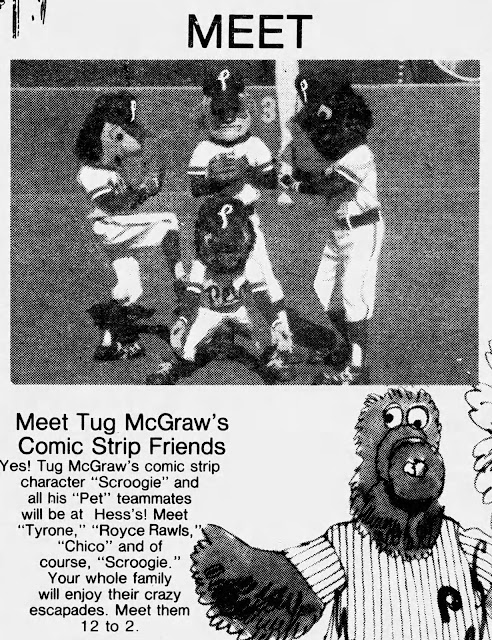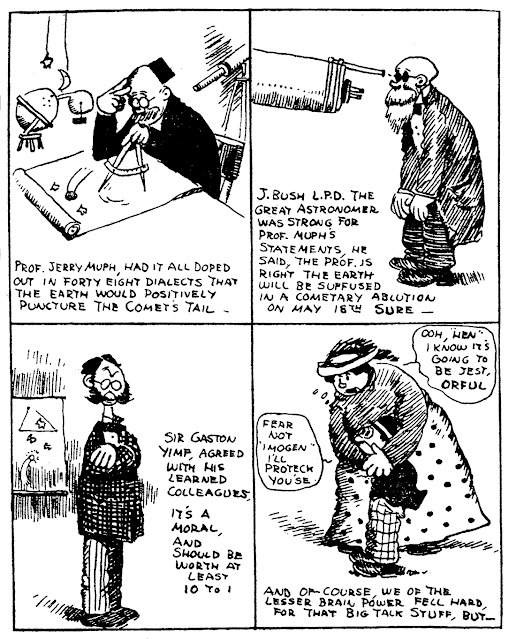Saturday, March 18, 2023
Herriman Saturday: May 20 1910
Halley's Comet is finally reaching the general environs of the Earth, and while some ordinary people are up in arms at the scary prospect, the scientists are happy to explain that everything is going according to predictions.
Labels: Herriman's LA Examiner Cartoons
Friday, March 17, 2023
Firsts and Lasts: The Final Spat of Mr. & Mrs.
Mister & Mrs. is a truly odd success story, a strip that survived for over forty years with essentially no fan base that I am aware of, or, for that matter, that I can imagine.
The strip debuted in 1919, helmed at first by the great Clare Briggs. Mr. & Mrs. sure didn't have much of the touch of greatness that Briggs could impart, though. The strip was about a bickering couple, Joe and Vi Green, and was quite depressing in its horrifically negative view of marriage. The couple were constantly at each other's throats and honestly seemed to be just one more fight away from either divorce or even homicide. The regular tagline of the strip, in which the couple's young son meekly whispers to the adult combatants, "Papa love mama?", heartbreaking as it is, seems to say it all.
Why would anyone want to read this? If the reader is unmarried, this strip is scary enough to make them swear off the institution. If happily married, it's a horror show of what could eventually be. If unhappily married, a confirmation that this is a perfectly normal situation, not one that will ever likely improve.
But what do I know? People read and seem to love Andy Capp and The Lockhorns, which are more of the same. So perhaps there's some weird fascination, a "there but by the grace of God go I", that draws an appreciative audience.
My guess is that Briggs had little to do with the Sunday strip; he probably took primarily a supervisory role once the ball was rolling. When he unexpectedly died in 1930 the strip was taken over by a series of lesser creators, without even the guidance of a brilliant manager. The new creators seemed content to continue the formula as long as the paychecks kept coming.
The last creator was Kin Platt, whose work on the strip began as artist only, from scripts by Arthur Folwell, in 1948. Platt's work at the outset was marginally attractive, but by the mid-50s was looking so crude and slapdash that you might think he was a doddery octogenarian; he was actually just in his 40s.
Folwell dropped out in 1957, and the daily strip (added after Briggs' death) was dropped in 1958, but Platt kept up the Sunday until September 22 1963. You might expect that Platt would have finally given readers what I'm sure they were hoping for all those years, a nice day in divorce court for Joe and Vi. But no, he elected to end the strip with a breaking of the fourth wall episode, and some final bickering from Jo and Vi before they went forever back in the inkwell.
Labels: Firsts and Lasts
Maybe marital strife fascinates some folks. Other people's, even make believe ones, social agony is quite interesting to the busybodies of the world, that's why there's soap operas. Unhappy couples seems to be niche comedy genré, look at The Bickersons or the Honeymooners.
The article says it's Capp railing against the treatment of Superman's creators, but it's focused tightly on newspaper comics so inspiration was probably closer to home. The evil syndicator rips off strip creators at every turn, finally by selling it to newspapers cheap -- if they buy an expensive feature by his own mother.
Is it possible Mr. & Mrs. served a similar function, a property owned outright by the syndicate (or an executive) that had to be bought to get more popular titles? Did every paper that bought it print it?
To EOCostello -- yes, and of all the platinum books out there, the Mr. & Mrs. is the one most often seen in really nice clean condition (mine was practically mint). Almost as if no one bothered to crack 'em open more than once.
--Allan
Wednesday, March 15, 2023
Ink-Slinger Profiles by Alex Jay: Harley Griffiths
Griffiths—On October 3, 1917, Harley Bradley Griffiths, beloved husband of May Mulcahy Griffiths. Funeral from his late residence 28 St. Mark’s place, at the convenience of the family. Interment Cypress Hills Cemetery.
Griffiths—On Sunday, Feb. 3, 1935, at 349 St. John’s Place, Edgar Charles Griffiths, beloved son of Mary M. And the late Harley Bradley Griffiths and brother of Harley M., Gloria J. and Muriel J. Griffiths. Funeral Wednesday, 9:30 a.m.; solemn mass of requiem St. Teresa’s R. C. Church. Interment in St. John’s Cemetery.
Miss Maher to Wed on July 10Is Bride-Elect of WesternerMrs. Francis Langford Maher of 395 Clinton Ave. announces the engagement and approaching marriage of her daughter, Miss Elizabeth Maher, to Harley Griffiths of Coronado Beach, Cal.Miss Maher, daughter of the late Francis L. Maher, is president of the Alumnae Association of the College of New Rochelle, She is also a graduate of St. Angela Hall and received her Masters Degree from Fordham University.Mr. Griffiths is the son of the late Mr. and Mrs. Harley Bradley Griffiths of Brooklyn. He is a graduate of. St. Augustine’s Academy and attended Pratt Institute and the National Academy of Design. Mr. Griffiths is associated with Consolidated Aircraft Company in San Diego, Cal.The wedding will take place on July 10.
Cathedral Is Scene of Miss Maher’s BridalMiss Elizabeth Maher, daughter of Mrs. Francis Langford Maher of 885 Clinton Ave. and the late Mr. Maher, was married yesterday to Harley Griffiths, son of the late Mr. and Mrs. Harley Bradley Griffiths of Coronado Beach, Cal. The ceremony was performed in the Lady Chapel of St. Patrick’s Cathedral, Manhattan, by Monsignor Joseph F. Flannelly and a reception followed at Sherry’s.Miss Maher was attended by her sister, Mrs. Edward T. Kelly of Kew Gardens, and Mrs. Amedeo Giorando of Manhattan. Francis L. Maher gave his sister in marriage. The bride wore a gown of white satin made with a sweetheart neckline. Her tulle veil was fastened by a braided satin cap and she carried her mother’s prayerbook with a marker of white orchids. The attendants wore turquoise blue crepe gowns and carried bouquets of pink delphinium and wore headdresses of similar flowers and blue tulle. White stock and blue delphinium decorated the chapel.William E. Frost of Forest Hills was best manned the ushers were Dr. Edward Brennan of Brooklyn and Ensign Daniel Sullivan of Cedarhurst.The bride received her education at St. Angela Hall and the College of new Rochelle and received her masters degree at Fordham university. She is president of the Alumnae Association of the College of New Rochelle. The bridegroom attended St. Augustine’s Academy, Pratt Institute and the National Academy of Design.Following a trip to Canada, the couple will reside in Allentown, Pa.
Harley Griffiths386 Weaver St. 2-1150Larchmont, N. Y.
Mr. Griffiths exhibited his work at galleries in Larchmont, Pelham, New York City and Nantucket His shows included the annual show of the Greenwich Art Association and the 50th annual show of the Hudson Valley Art Association.For more than 25 years, he was a commercial artist and illustrator for B. Altman & Co. He retired in 1975 and became a free-lance artist. Mr. Griffiths lived in Larchmont for 46 years and spent most of his summers on Nantucket. In Larchmont he was a parishioner of St. Augustines Church. Mr. Griffiths was a member of the Nantucket Artists Association and the National Arts Club of New York.
Labels: Ink-Slinger Profiles
Monday, March 13, 2023
Obscurity of the Day: Scroogie
In the 1960s and 70s, Tug McGraw was a star relief pitcher for the Mets, then the Phillies, and a gregarious colorful character embraced by baseball fans. He chose to parley that goodwill into, of all things, a daily and Sunday newspaper comic strip.
The strip was titled Scroogie, starring (who else?) a major-league relief pitcher, playing for the Pets. Scroogie's main co-star is Tyrone, his best buddy and outfielder. Other characters include Homer, a dimwitted slugger; Millicent Cashman, owner of the team; and Royce Rawls, a starting pitcher. Many characters were loosely based on McGraw's real-life teammates, and real player names were often dropped for gags in the strip.
The strip, which was syndicated by the Chicago Tribune-New York News Syndicate, offered a somewhat different take on the world of pro sports owing to a creator who was actually experiencing that world from the inside. The strip was much more realistic than old-school baseball epics like Ozark Ike. Gags often target the fans, managers and owners, and predictably there's a lot of material about the existential dread of a relief pitcher, the perennial hero or goat in every appearance.
The real problem with any baseball strip, though, is what to do in the off-season. Options are slim -- you can either ignore reality and have your team blithely playing away in January, or you can find other things for your characters to do from November to March. Scroogie gave its characterts an off-season, and filled much of the time with what players do on their vacations. Scroogie and Tyrone also took a shot at playing pro football, a ridiculous contrivance also favoured by other sports strips in the past.
Although Tug McGraw conceived the strip and tried to keep a hand in it, the day to day creation of Scroogie was handled by the uncredited writers Dave Fisher and Neil Offen, and the credited artist Mike Witte. The strip debuted on March 17 1975* (just in time for spring training) in a pretty healthy number of papers. The other shoe fell, though, when the baseball season was over and papers inevitably started dropping the strip. With two writers, an artist, a syndicate and a pro baseball player all on the payroll, the strip soon failed to pull its weight. Scroogie was retired after just over two years, on April 24 1977**. The final Sunday strip (with a very funny gag) is our bottom sample. Oddly enough, McGraw made claims that he was going to revive the strip, self-syndicated. As far as I know this never came to pass. What did come to pass, though, is that McGraw had some costumes created of the characters and booked actors to wear them for personal appearances for several years after the strip ended:
 |
| Mall appearance in Allentown, March 1979 |
During its short life Scroogie appeared in two paperback collections, Scroogie (Signet, 1976) and Hello There Ball (Signet, 1977).
Oh, and why name the strip's main character Scroogie? That's baseball jargon for a screwball pitcher, an infamously tough pitch for pitchers to master, and when thrown correctly, for hitters to hit. Tug McGraw was a screwball pitcher, one of the best.
* Source: Editor & Publisher, February 15 1975
** Source: Oakland Tribune
Labels: Obscurities
Sunday, March 12, 2023
Wish You Were Here, from Little Nemo
What an odd little snippet of poetry in this Little Nemo Valentine's postcard issued by Tuck:
Though, princess,
Nemo's far away.
He'll love but you,
For aye and aye.
I sure don't get that 'aye and aye' business, but a quick Google reveals that the phrase has currency in other poems as well. Basically it seems like it's a fancy way of saying 'forever'. Who says comics don't teach you stuff.
Anyway, the game with these Little Nemo cards is to find the source of the scene in the original McCay Sunday strips. Can you find it?
Labels: Wish You Were Here
https://www.comicstriplibrary.org/display/410














